SOC10236 Applied Ethics and Sustainability: Footprint Analysis
VerifiedAdded on 2023/03/21
|12
|3554
|37
Report
AI Summary
This report presents an analysis of a personal ecological footprint calculated using the WWF calculator. It interprets the footprint in global hectares and carbon tonnes, comparing it to global benchmarks and forestry carbon sequestration rates. The analysis identifies major causes of unsustainable lifestyle aspects related to city living, energy consumption, food choices, and population impact, proposing potential solutions for each. A product lifecycle assessment of solar chimneys is included, identifying unsustainability causes in production, distribution, and disposal. Finally, the report applies the 'waste=food' model and cradle-to-cradle design principles to recommend waste reduction strategies, emphasizing toxicity reduction, material efficiency, and recycling to foster sustainability. This document is available on Desklib, a platform offering a wide range of study resources for students.
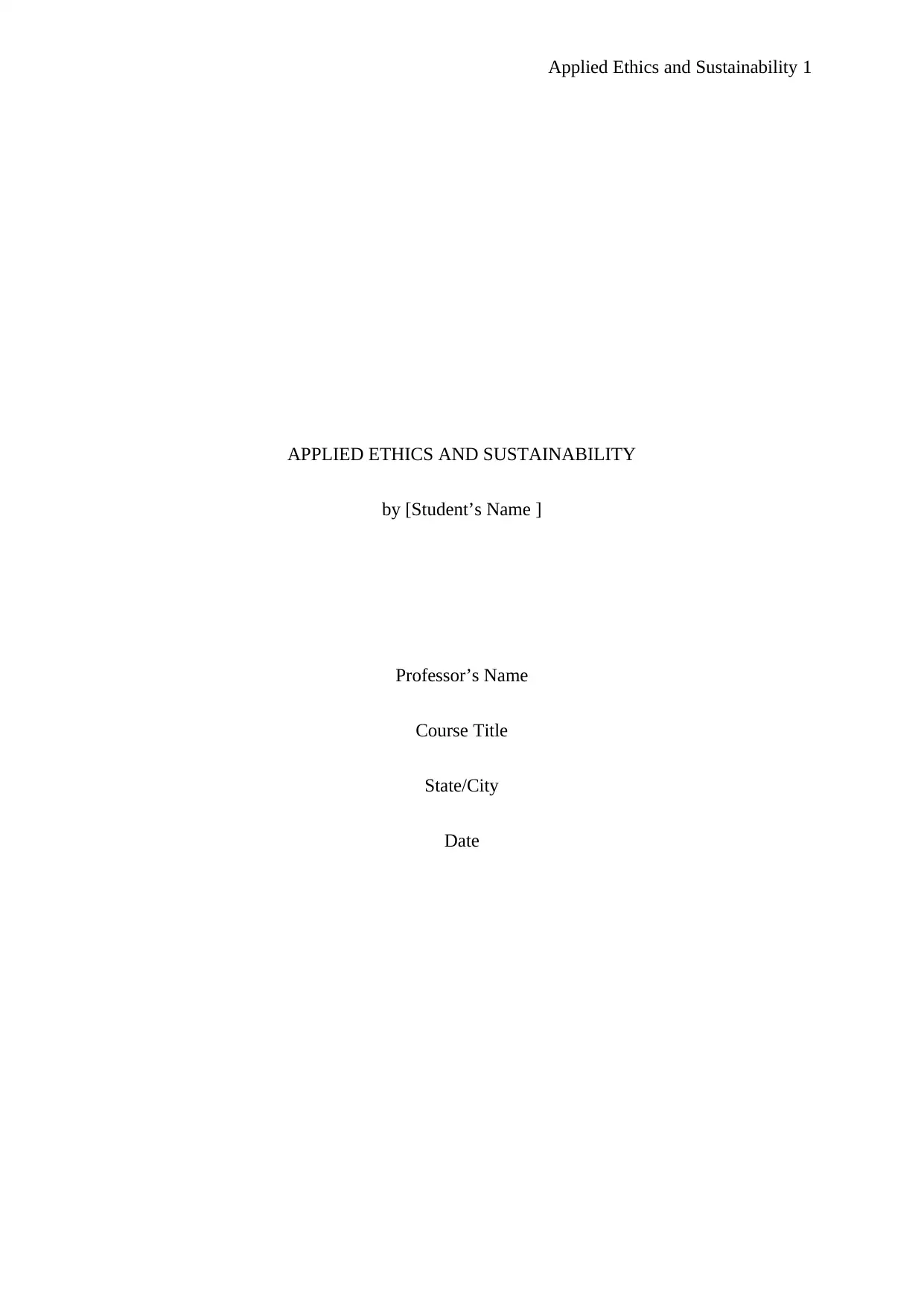
Applied Ethics and Sustainability 1
APPLIED ETHICS AND SUSTAINABILITY
by [Student’s Name ]
Professor’s Name
Course Title
State/City
Date
APPLIED ETHICS AND SUSTAINABILITY
by [Student’s Name ]
Professor’s Name
Course Title
State/City
Date
Paraphrase This Document
Need a fresh take? Get an instant paraphrase of this document with our AI Paraphraser
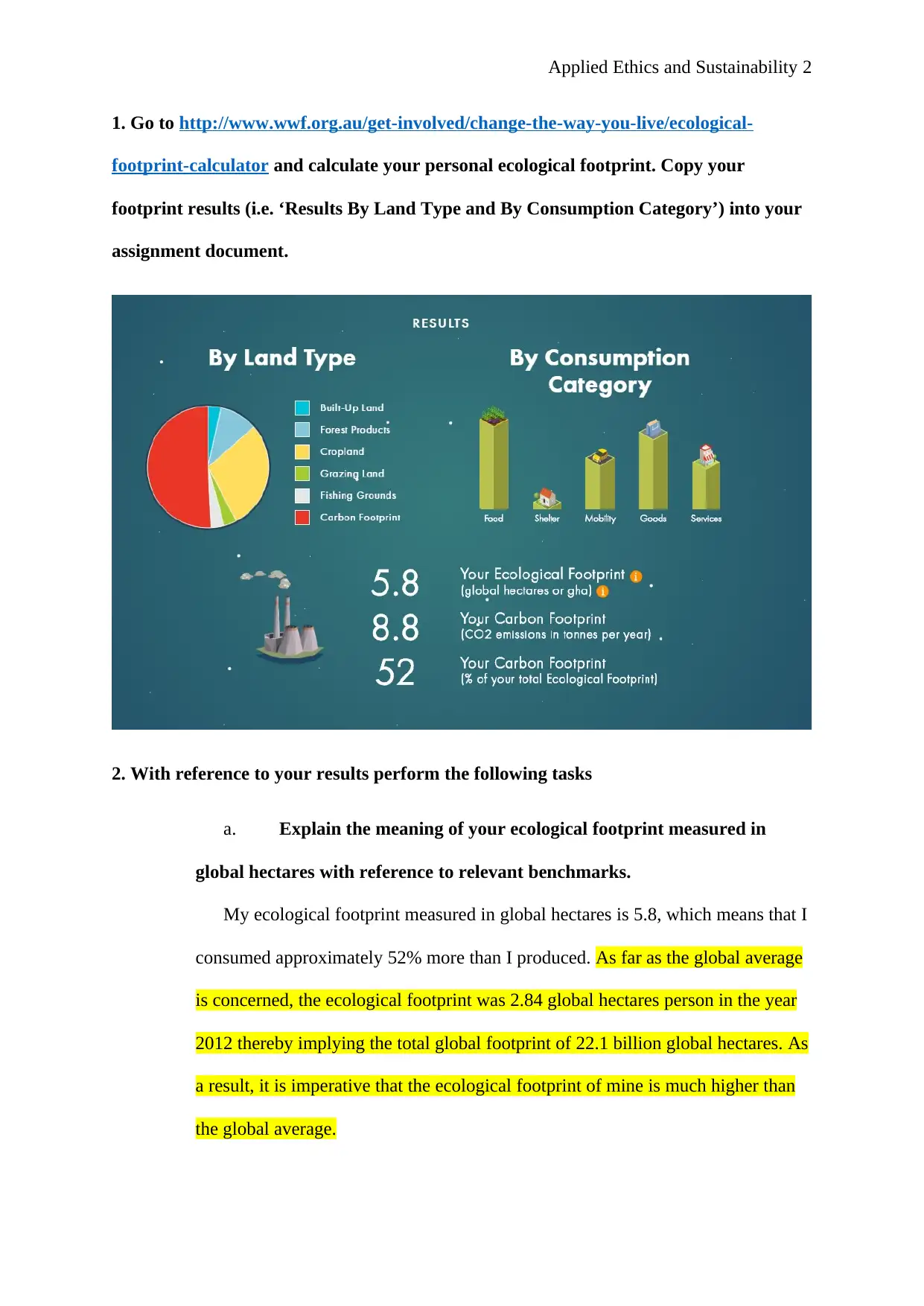
Applied Ethics and Sustainability 2
1. Go to http://www.wwf.org.au/get-involved/change-the-way-you-live/ecological-
footprint-calculator and calculate your personal ecological footprint. Copy your
footprint results (i.e. ‘Results By Land Type and By Consumption Category’) into your
assignment document.
2. With reference to your results perform the following tasks
a. Explain the meaning of your ecological footprint measured in
global hectares with reference to relevant benchmarks.
My ecological footprint measured in global hectares is 5.8, which means that I
consumed approximately 52% more than I produced. As far as the global average
is concerned, the ecological footprint was 2.84 global hectares person in the year
2012 thereby implying the total global footprint of 22.1 billion global hectares. As
a result, it is imperative that the ecological footprint of mine is much higher than
the global average.
1. Go to http://www.wwf.org.au/get-involved/change-the-way-you-live/ecological-
footprint-calculator and calculate your personal ecological footprint. Copy your
footprint results (i.e. ‘Results By Land Type and By Consumption Category’) into your
assignment document.
2. With reference to your results perform the following tasks
a. Explain the meaning of your ecological footprint measured in
global hectares with reference to relevant benchmarks.
My ecological footprint measured in global hectares is 5.8, which means that I
consumed approximately 52% more than I produced. As far as the global average
is concerned, the ecological footprint was 2.84 global hectares person in the year
2012 thereby implying the total global footprint of 22.1 billion global hectares. As
a result, it is imperative that the ecological footprint of mine is much higher than
the global average.
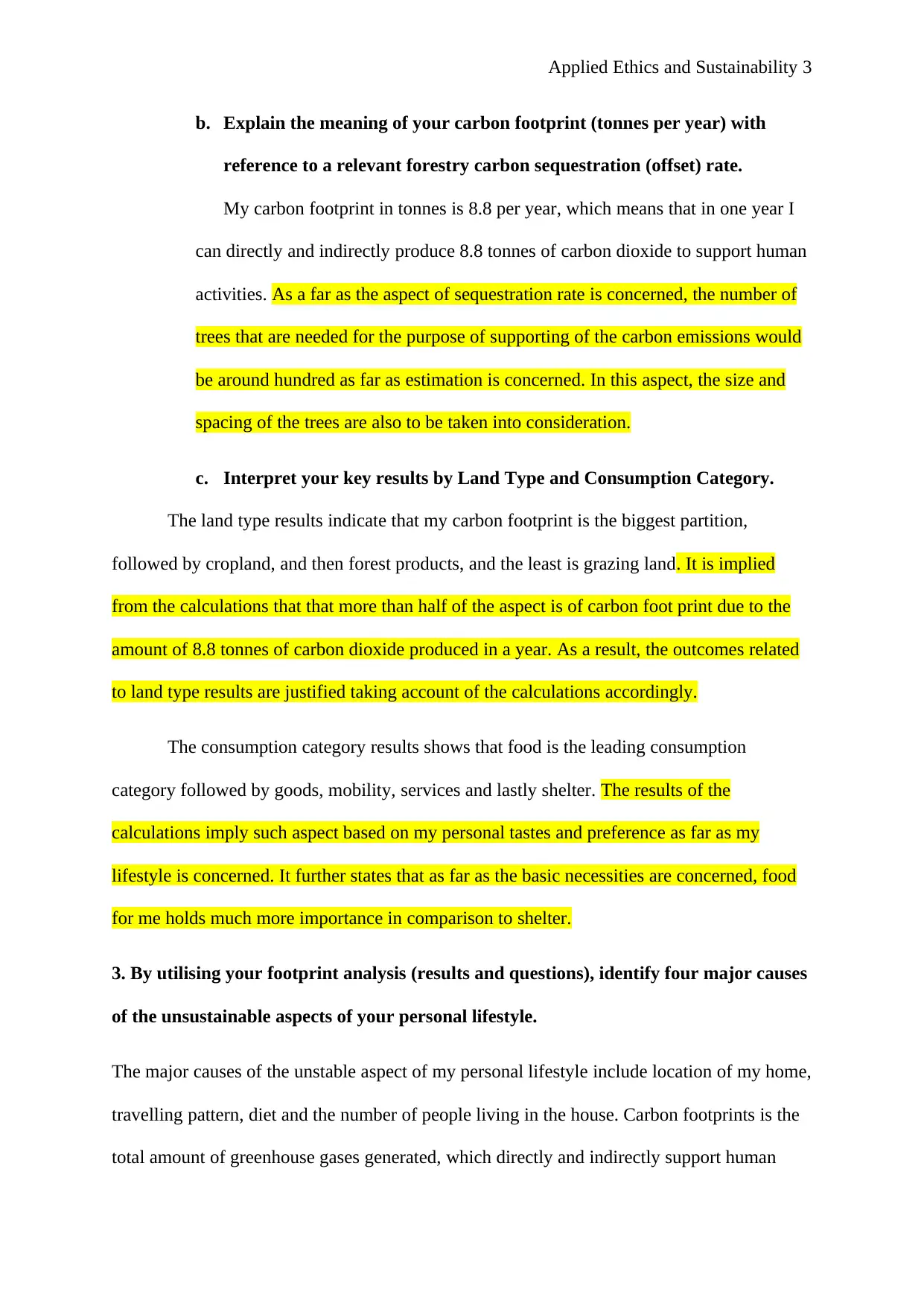
Applied Ethics and Sustainability 3
b. Explain the meaning of your carbon footprint (tonnes per year) with
reference to a relevant forestry carbon sequestration (offset) rate.
My carbon footprint in tonnes is 8.8 per year, which means that in one year I
can directly and indirectly produce 8.8 tonnes of carbon dioxide to support human
activities. As a far as the aspect of sequestration rate is concerned, the number of
trees that are needed for the purpose of supporting of the carbon emissions would
be around hundred as far as estimation is concerned. In this aspect, the size and
spacing of the trees are also to be taken into consideration.
c. Interpret your key results by Land Type and Consumption Category.
The land type results indicate that my carbon footprint is the biggest partition,
followed by cropland, and then forest products, and the least is grazing land. It is implied
from the calculations that that more than half of the aspect is of carbon foot print due to the
amount of 8.8 tonnes of carbon dioxide produced in a year. As a result, the outcomes related
to land type results are justified taking account of the calculations accordingly.
The consumption category results shows that food is the leading consumption
category followed by goods, mobility, services and lastly shelter. The results of the
calculations imply such aspect based on my personal tastes and preference as far as my
lifestyle is concerned. It further states that as far as the basic necessities are concerned, food
for me holds much more importance in comparison to shelter.
3. By utilising your footprint analysis (results and questions), identify four major causes
of the unsustainable aspects of your personal lifestyle.
The major causes of the unstable aspect of my personal lifestyle include location of my home,
travelling pattern, diet and the number of people living in the house. Carbon footprints is the
total amount of greenhouse gases generated, which directly and indirectly support human
b. Explain the meaning of your carbon footprint (tonnes per year) with
reference to a relevant forestry carbon sequestration (offset) rate.
My carbon footprint in tonnes is 8.8 per year, which means that in one year I
can directly and indirectly produce 8.8 tonnes of carbon dioxide to support human
activities. As a far as the aspect of sequestration rate is concerned, the number of
trees that are needed for the purpose of supporting of the carbon emissions would
be around hundred as far as estimation is concerned. In this aspect, the size and
spacing of the trees are also to be taken into consideration.
c. Interpret your key results by Land Type and Consumption Category.
The land type results indicate that my carbon footprint is the biggest partition,
followed by cropland, and then forest products, and the least is grazing land. It is implied
from the calculations that that more than half of the aspect is of carbon foot print due to the
amount of 8.8 tonnes of carbon dioxide produced in a year. As a result, the outcomes related
to land type results are justified taking account of the calculations accordingly.
The consumption category results shows that food is the leading consumption
category followed by goods, mobility, services and lastly shelter. The results of the
calculations imply such aspect based on my personal tastes and preference as far as my
lifestyle is concerned. It further states that as far as the basic necessities are concerned, food
for me holds much more importance in comparison to shelter.
3. By utilising your footprint analysis (results and questions), identify four major causes
of the unsustainable aspects of your personal lifestyle.
The major causes of the unstable aspect of my personal lifestyle include location of my home,
travelling pattern, diet and the number of people living in the house. Carbon footprints is the
total amount of greenhouse gases generated, which directly and indirectly support human
⊘ This is a preview!⊘
Do you want full access?
Subscribe today to unlock all pages.

Trusted by 1+ million students worldwide
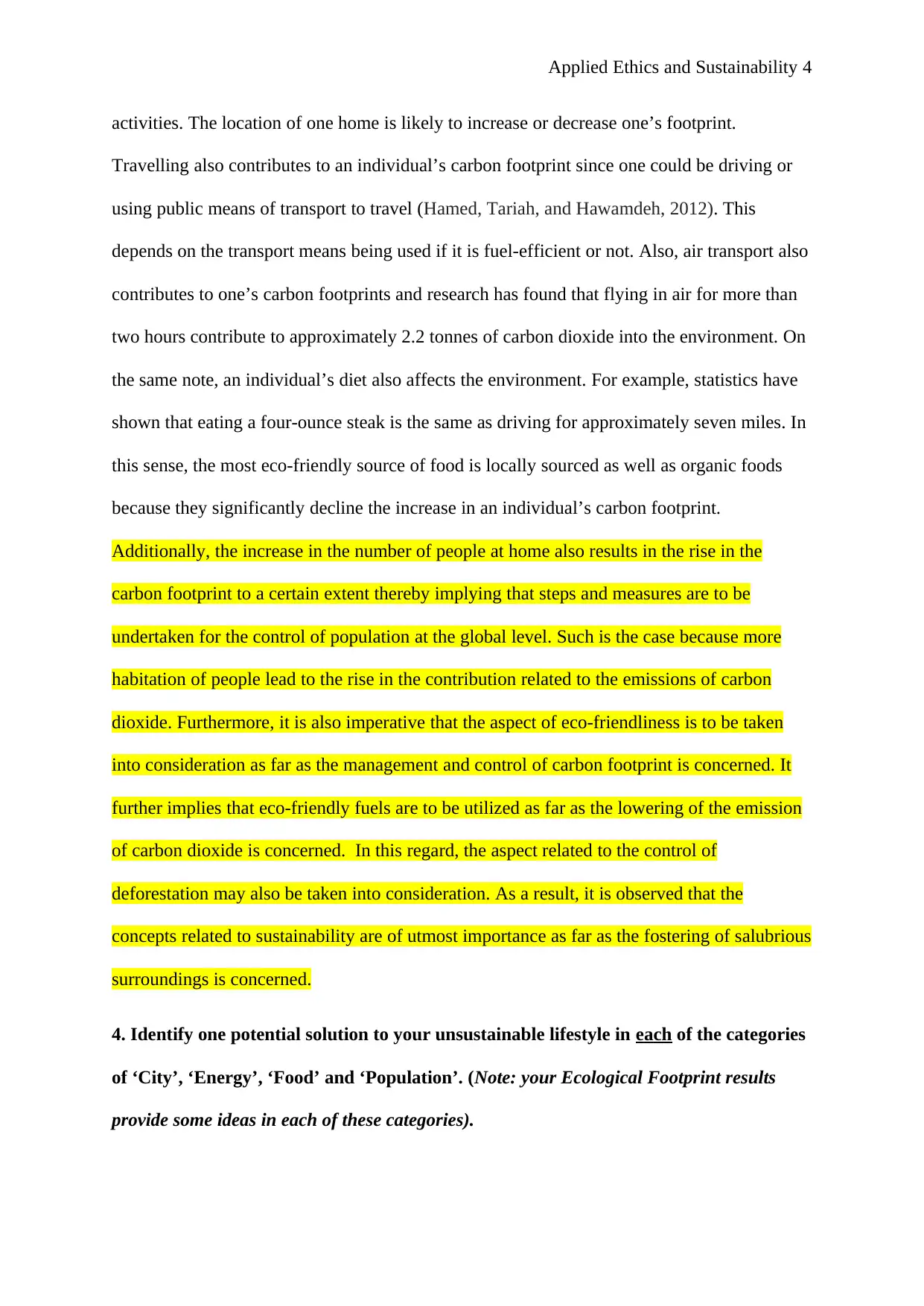
Applied Ethics and Sustainability 4
activities. The location of one home is likely to increase or decrease one’s footprint.
Travelling also contributes to an individual’s carbon footprint since one could be driving or
using public means of transport to travel (Hamed, Tariah, and Hawamdeh, 2012). This
depends on the transport means being used if it is fuel-efficient or not. Also, air transport also
contributes to one’s carbon footprints and research has found that flying in air for more than
two hours contribute to approximately 2.2 tonnes of carbon dioxide into the environment. On
the same note, an individual’s diet also affects the environment. For example, statistics have
shown that eating a four-ounce steak is the same as driving for approximately seven miles. In
this sense, the most eco-friendly source of food is locally sourced as well as organic foods
because they significantly decline the increase in an individual’s carbon footprint.
Additionally, the increase in the number of people at home also results in the rise in the
carbon footprint to a certain extent thereby implying that steps and measures are to be
undertaken for the control of population at the global level. Such is the case because more
habitation of people lead to the rise in the contribution related to the emissions of carbon
dioxide. Furthermore, it is also imperative that the aspect of eco-friendliness is to be taken
into consideration as far as the management and control of carbon footprint is concerned. It
further implies that eco-friendly fuels are to be utilized as far as the lowering of the emission
of carbon dioxide is concerned. In this regard, the aspect related to the control of
deforestation may also be taken into consideration. As a result, it is observed that the
concepts related to sustainability are of utmost importance as far as the fostering of salubrious
surroundings is concerned.
4. Identify one potential solution to your unsustainable lifestyle in each of the categories
of ‘City’, ‘Energy’, ‘Food’ and ‘Population’. (Note: your Ecological Footprint results
provide some ideas in each of these categories).
activities. The location of one home is likely to increase or decrease one’s footprint.
Travelling also contributes to an individual’s carbon footprint since one could be driving or
using public means of transport to travel (Hamed, Tariah, and Hawamdeh, 2012). This
depends on the transport means being used if it is fuel-efficient or not. Also, air transport also
contributes to one’s carbon footprints and research has found that flying in air for more than
two hours contribute to approximately 2.2 tonnes of carbon dioxide into the environment. On
the same note, an individual’s diet also affects the environment. For example, statistics have
shown that eating a four-ounce steak is the same as driving for approximately seven miles. In
this sense, the most eco-friendly source of food is locally sourced as well as organic foods
because they significantly decline the increase in an individual’s carbon footprint.
Additionally, the increase in the number of people at home also results in the rise in the
carbon footprint to a certain extent thereby implying that steps and measures are to be
undertaken for the control of population at the global level. Such is the case because more
habitation of people lead to the rise in the contribution related to the emissions of carbon
dioxide. Furthermore, it is also imperative that the aspect of eco-friendliness is to be taken
into consideration as far as the management and control of carbon footprint is concerned. It
further implies that eco-friendly fuels are to be utilized as far as the lowering of the emission
of carbon dioxide is concerned. In this regard, the aspect related to the control of
deforestation may also be taken into consideration. As a result, it is observed that the
concepts related to sustainability are of utmost importance as far as the fostering of salubrious
surroundings is concerned.
4. Identify one potential solution to your unsustainable lifestyle in each of the categories
of ‘City’, ‘Energy’, ‘Food’ and ‘Population’. (Note: your Ecological Footprint results
provide some ideas in each of these categories).
Paraphrase This Document
Need a fresh take? Get an instant paraphrase of this document with our AI Paraphraser
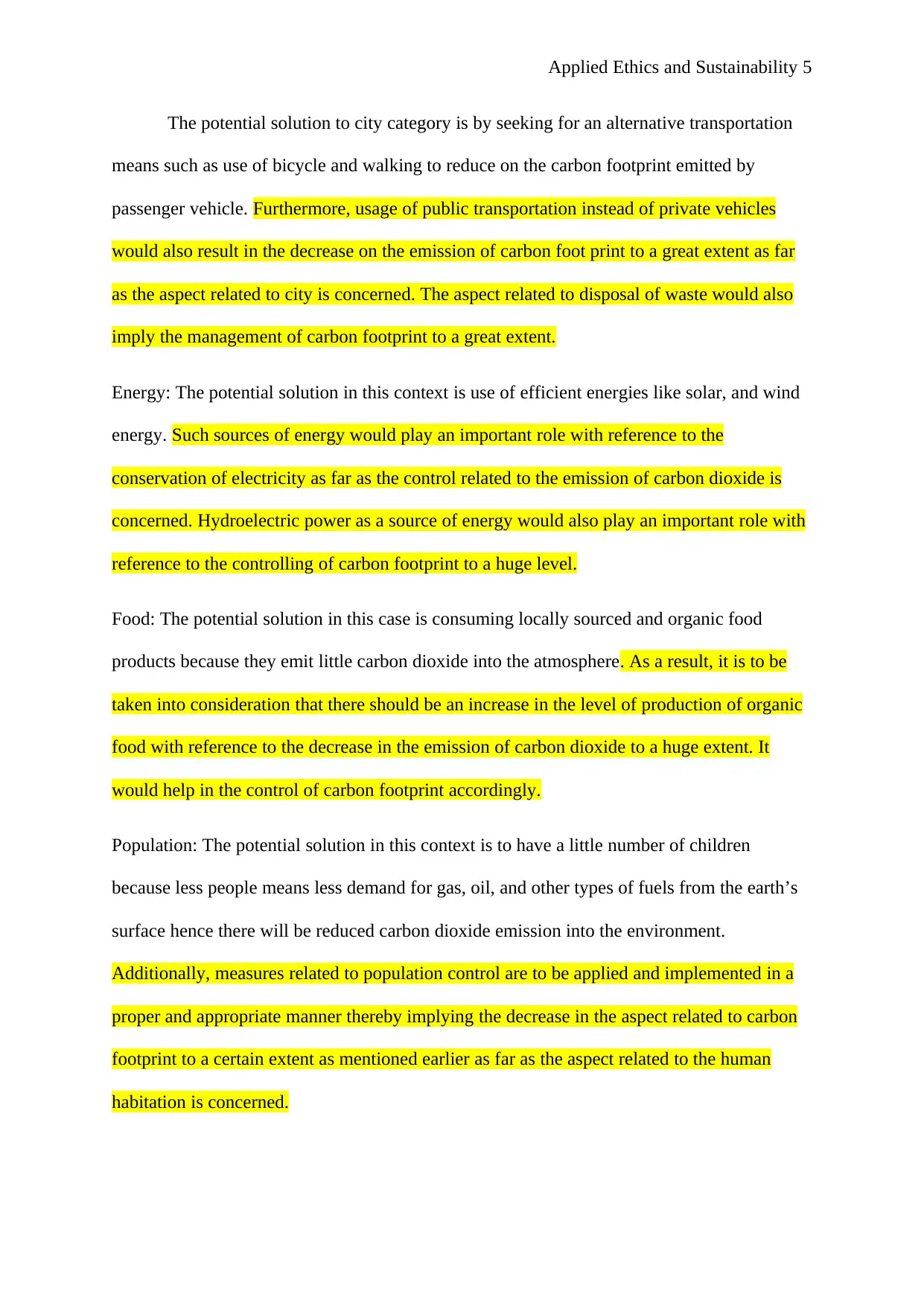
Applied Ethics and Sustainability 5
The potential solution to city category is by seeking for an alternative transportation
means such as use of bicycle and walking to reduce on the carbon footprint emitted by
passenger vehicle. Furthermore, usage of public transportation instead of private vehicles
would also result in the decrease on the emission of carbon foot print to a great extent as far
as the aspect related to city is concerned. The aspect related to disposal of waste would also
imply the management of carbon footprint to a great extent.
Energy: The potential solution in this context is use of efficient energies like solar, and wind
energy. Such sources of energy would play an important role with reference to the
conservation of electricity as far as the control related to the emission of carbon dioxide is
concerned. Hydroelectric power as a source of energy would also play an important role with
reference to the controlling of carbon footprint to a huge level.
Food: The potential solution in this case is consuming locally sourced and organic food
products because they emit little carbon dioxide into the atmosphere. As a result, it is to be
taken into consideration that there should be an increase in the level of production of organic
food with reference to the decrease in the emission of carbon dioxide to a huge extent. It
would help in the control of carbon footprint accordingly.
Population: The potential solution in this context is to have a little number of children
because less people means less demand for gas, oil, and other types of fuels from the earth’s
surface hence there will be reduced carbon dioxide emission into the environment.
Additionally, measures related to population control are to be applied and implemented in a
proper and appropriate manner thereby implying the decrease in the aspect related to carbon
footprint to a certain extent as mentioned earlier as far as the aspect related to the human
habitation is concerned.
The potential solution to city category is by seeking for an alternative transportation
means such as use of bicycle and walking to reduce on the carbon footprint emitted by
passenger vehicle. Furthermore, usage of public transportation instead of private vehicles
would also result in the decrease on the emission of carbon foot print to a great extent as far
as the aspect related to city is concerned. The aspect related to disposal of waste would also
imply the management of carbon footprint to a great extent.
Energy: The potential solution in this context is use of efficient energies like solar, and wind
energy. Such sources of energy would play an important role with reference to the
conservation of electricity as far as the control related to the emission of carbon dioxide is
concerned. Hydroelectric power as a source of energy would also play an important role with
reference to the controlling of carbon footprint to a huge level.
Food: The potential solution in this case is consuming locally sourced and organic food
products because they emit little carbon dioxide into the atmosphere. As a result, it is to be
taken into consideration that there should be an increase in the level of production of organic
food with reference to the decrease in the emission of carbon dioxide to a huge extent. It
would help in the control of carbon footprint accordingly.
Population: The potential solution in this context is to have a little number of children
because less people means less demand for gas, oil, and other types of fuels from the earth’s
surface hence there will be reduced carbon dioxide emission into the environment.
Additionally, measures related to population control are to be applied and implemented in a
proper and appropriate manner thereby implying the decrease in the aspect related to carbon
footprint to a certain extent as mentioned earlier as far as the aspect related to the human
habitation is concerned.
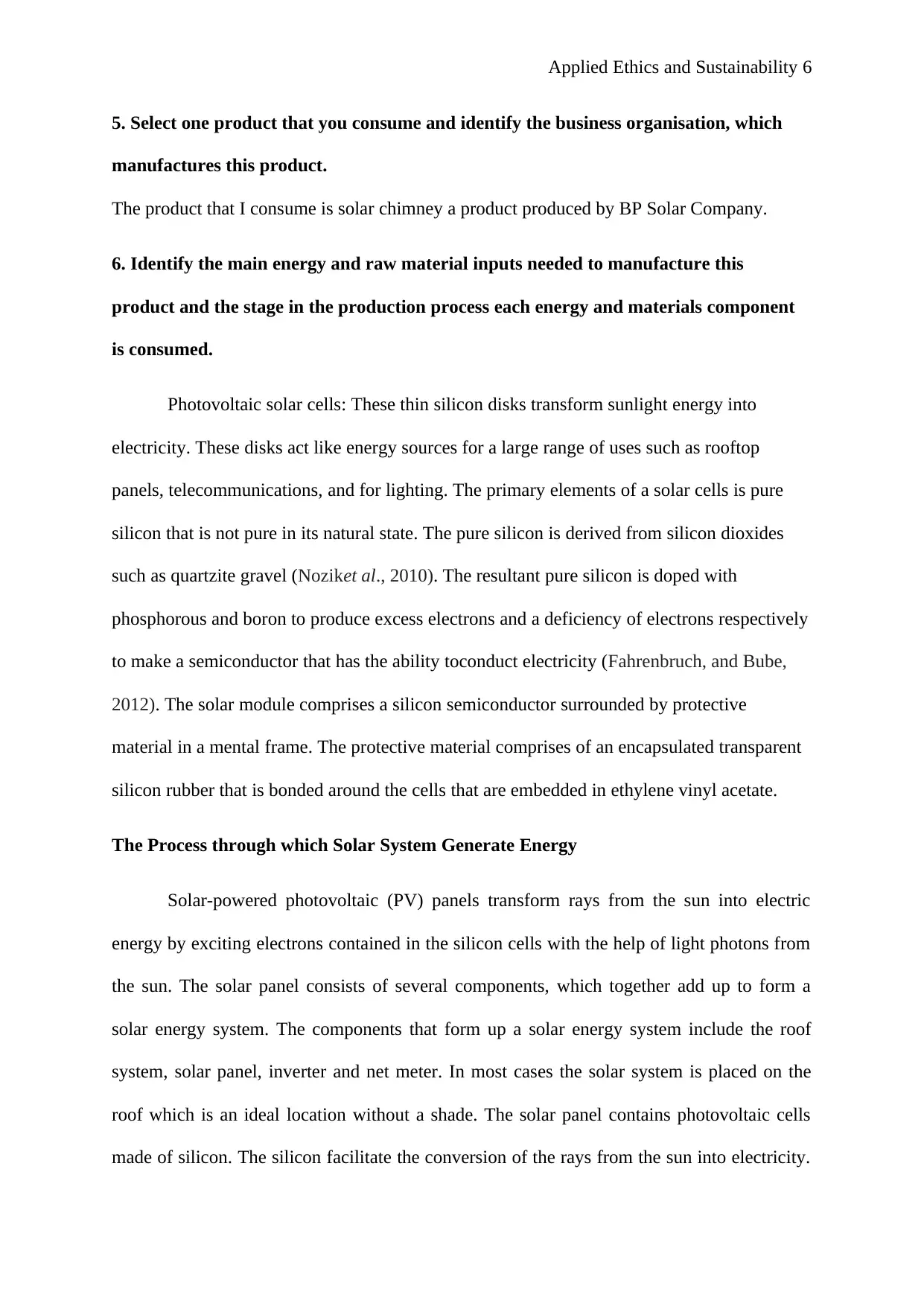
Applied Ethics and Sustainability 6
5. Select one product that you consume and identify the business organisation, which
manufactures this product.
The product that I consume is solar chimney a product produced by BP Solar Company.
6. Identify the main energy and raw material inputs needed to manufacture this
product and the stage in the production process each energy and materials component
is consumed.
Photovoltaic solar cells: These thin silicon disks transform sunlight energy into
electricity. These disks act like energy sources for a large range of uses such as rooftop
panels, telecommunications, and for lighting. The primary elements of a solar cells is pure
silicon that is not pure in its natural state. The pure silicon is derived from silicon dioxides
such as quartzite gravel (Noziket al., 2010). The resultant pure silicon is doped with
phosphorous and boron to produce excess electrons and a deficiency of electrons respectively
to make a semiconductor that has the ability toconduct electricity (Fahrenbruch, and Bube,
2012). The solar module comprises a silicon semiconductor surrounded by protective
material in a mental frame. The protective material comprises of an encapsulated transparent
silicon rubber that is bonded around the cells that are embedded in ethylene vinyl acetate.
The Process through which Solar System Generate Energy
Solar-powered photovoltaic (PV) panels transform rays from the sun into electric
energy by exciting electrons contained in the silicon cells with the help of light photons from
the sun. The solar panel consists of several components, which together add up to form a
solar energy system. The components that form up a solar energy system include the roof
system, solar panel, inverter and net meter. In most cases the solar system is placed on the
roof which is an ideal location without a shade. The solar panel contains photovoltaic cells
made of silicon. The silicon facilitate the conversion of the rays from the sun into electricity.
5. Select one product that you consume and identify the business organisation, which
manufactures this product.
The product that I consume is solar chimney a product produced by BP Solar Company.
6. Identify the main energy and raw material inputs needed to manufacture this
product and the stage in the production process each energy and materials component
is consumed.
Photovoltaic solar cells: These thin silicon disks transform sunlight energy into
electricity. These disks act like energy sources for a large range of uses such as rooftop
panels, telecommunications, and for lighting. The primary elements of a solar cells is pure
silicon that is not pure in its natural state. The pure silicon is derived from silicon dioxides
such as quartzite gravel (Noziket al., 2010). The resultant pure silicon is doped with
phosphorous and boron to produce excess electrons and a deficiency of electrons respectively
to make a semiconductor that has the ability toconduct electricity (Fahrenbruch, and Bube,
2012). The solar module comprises a silicon semiconductor surrounded by protective
material in a mental frame. The protective material comprises of an encapsulated transparent
silicon rubber that is bonded around the cells that are embedded in ethylene vinyl acetate.
The Process through which Solar System Generate Energy
Solar-powered photovoltaic (PV) panels transform rays from the sun into electric
energy by exciting electrons contained in the silicon cells with the help of light photons from
the sun. The solar panel consists of several components, which together add up to form a
solar energy system. The components that form up a solar energy system include the roof
system, solar panel, inverter and net meter. In most cases the solar system is placed on the
roof which is an ideal location without a shade. The solar panel contains photovoltaic cells
made of silicon. The silicon facilitate the conversion of the rays from the sun into electricity.
⊘ This is a preview!⊘
Do you want full access?
Subscribe today to unlock all pages.

Trusted by 1+ million students worldwide
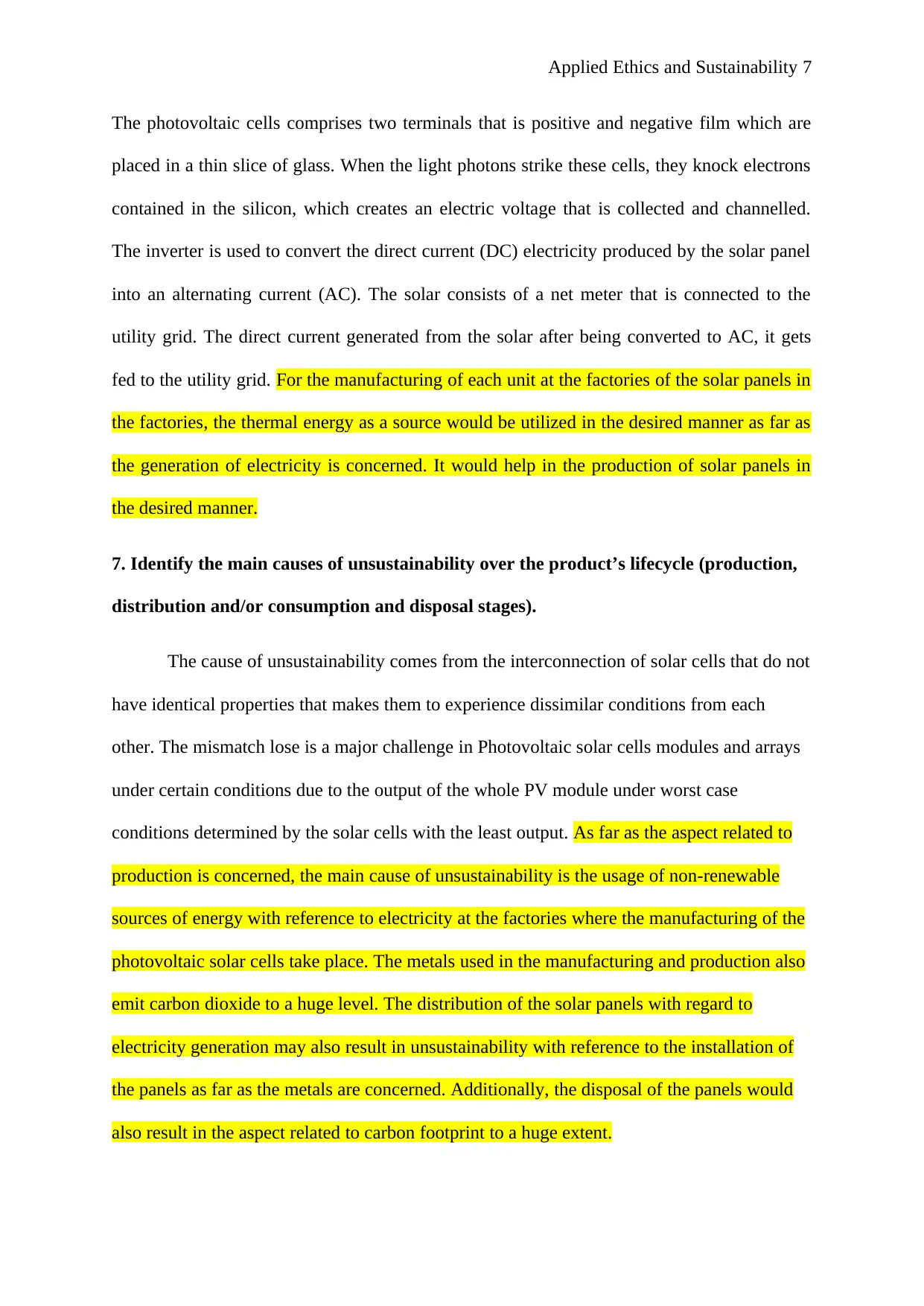
Applied Ethics and Sustainability 7
The photovoltaic cells comprises two terminals that is positive and negative film which are
placed in a thin slice of glass. When the light photons strike these cells, they knock electrons
contained in the silicon, which creates an electric voltage that is collected and channelled.
The inverter is used to convert the direct current (DC) electricity produced by the solar panel
into an alternating current (AC). The solar consists of a net meter that is connected to the
utility grid. The direct current generated from the solar after being converted to AC, it gets
fed to the utility grid. For the manufacturing of each unit at the factories of the solar panels in
the factories, the thermal energy as a source would be utilized in the desired manner as far as
the generation of electricity is concerned. It would help in the production of solar panels in
the desired manner.
7. Identify the main causes of unsustainability over the product’s lifecycle (production,
distribution and/or consumption and disposal stages).
The cause of unsustainability comes from the interconnection of solar cells that do not
have identical properties that makes them to experience dissimilar conditions from each
other. The mismatch lose is a major challenge in Photovoltaic solar cells modules and arrays
under certain conditions due to the output of the whole PV module under worst case
conditions determined by the solar cells with the least output. As far as the aspect related to
production is concerned, the main cause of unsustainability is the usage of non-renewable
sources of energy with reference to electricity at the factories where the manufacturing of the
photovoltaic solar cells take place. The metals used in the manufacturing and production also
emit carbon dioxide to a huge level. The distribution of the solar panels with regard to
electricity generation may also result in unsustainability with reference to the installation of
the panels as far as the metals are concerned. Additionally, the disposal of the panels would
also result in the aspect related to carbon footprint to a huge extent.
The photovoltaic cells comprises two terminals that is positive and negative film which are
placed in a thin slice of glass. When the light photons strike these cells, they knock electrons
contained in the silicon, which creates an electric voltage that is collected and channelled.
The inverter is used to convert the direct current (DC) electricity produced by the solar panel
into an alternating current (AC). The solar consists of a net meter that is connected to the
utility grid. The direct current generated from the solar after being converted to AC, it gets
fed to the utility grid. For the manufacturing of each unit at the factories of the solar panels in
the factories, the thermal energy as a source would be utilized in the desired manner as far as
the generation of electricity is concerned. It would help in the production of solar panels in
the desired manner.
7. Identify the main causes of unsustainability over the product’s lifecycle (production,
distribution and/or consumption and disposal stages).
The cause of unsustainability comes from the interconnection of solar cells that do not
have identical properties that makes them to experience dissimilar conditions from each
other. The mismatch lose is a major challenge in Photovoltaic solar cells modules and arrays
under certain conditions due to the output of the whole PV module under worst case
conditions determined by the solar cells with the least output. As far as the aspect related to
production is concerned, the main cause of unsustainability is the usage of non-renewable
sources of energy with reference to electricity at the factories where the manufacturing of the
photovoltaic solar cells take place. The metals used in the manufacturing and production also
emit carbon dioxide to a huge level. The distribution of the solar panels with regard to
electricity generation may also result in unsustainability with reference to the installation of
the panels as far as the metals are concerned. Additionally, the disposal of the panels would
also result in the aspect related to carbon footprint to a huge extent.
Paraphrase This Document
Need a fresh take? Get an instant paraphrase of this document with our AI Paraphraser
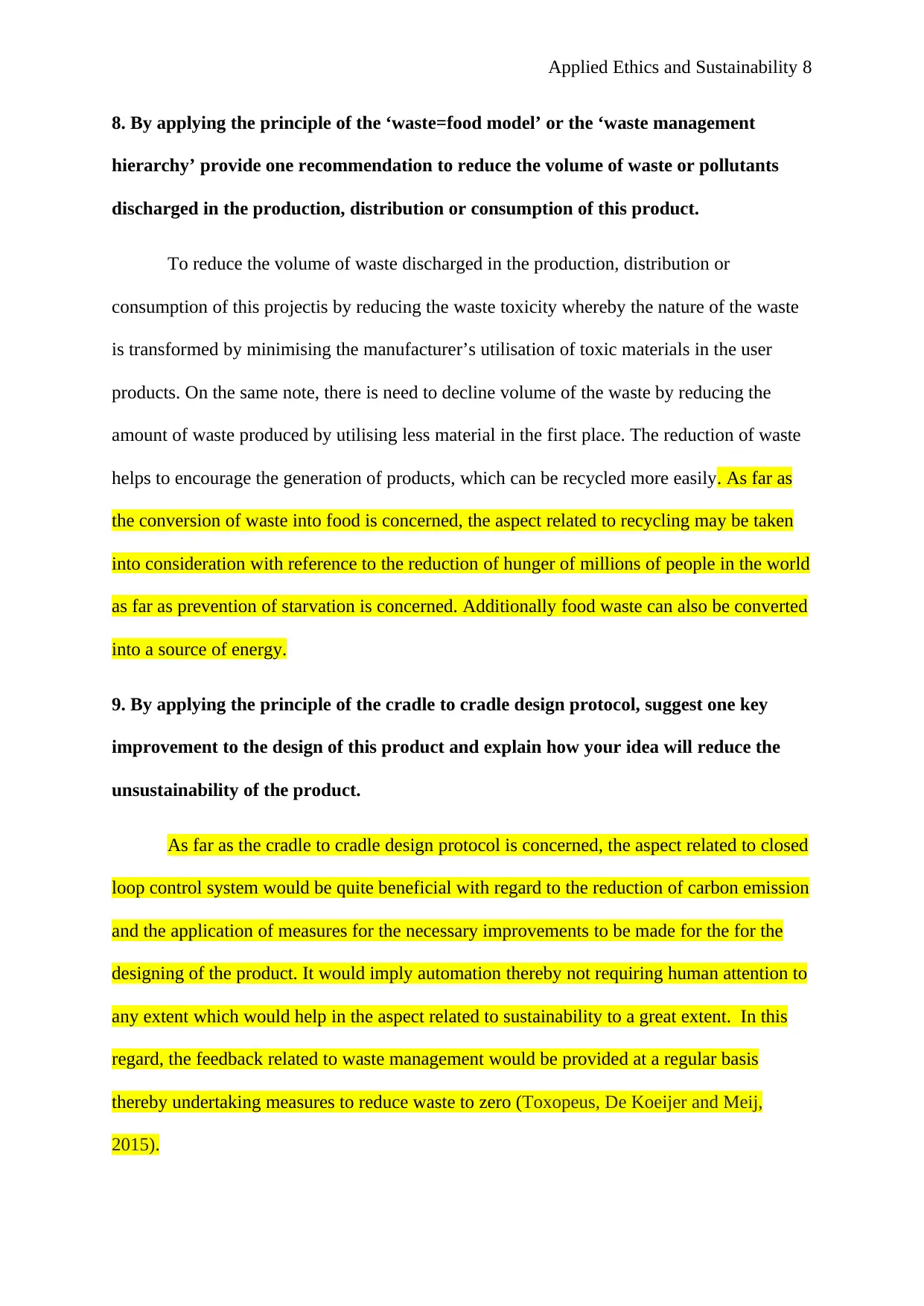
Applied Ethics and Sustainability 8
8. By applying the principle of the ‘waste=food model’ or the ‘waste management
hierarchy’ provide one recommendation to reduce the volume of waste or pollutants
discharged in the production, distribution or consumption of this product.
To reduce the volume of waste discharged in the production, distribution or
consumption of this projectis by reducing the waste toxicity whereby the nature of the waste
is transformed by minimising the manufacturer’s utilisation of toxic materials in the user
products. On the same note, there is need to decline volume of the waste by reducing the
amount of waste produced by utilising less material in the first place. The reduction of waste
helps to encourage the generation of products, which can be recycled more easily. As far as
the conversion of waste into food is concerned, the aspect related to recycling may be taken
into consideration with reference to the reduction of hunger of millions of people in the world
as far as prevention of starvation is concerned. Additionally food waste can also be converted
into a source of energy.
9. By applying the principle of the cradle to cradle design protocol, suggest one key
improvement to the design of this product and explain how your idea will reduce the
unsustainability of the product.
As far as the cradle to cradle design protocol is concerned, the aspect related to closed
loop control system would be quite beneficial with regard to the reduction of carbon emission
and the application of measures for the necessary improvements to be made for the for the
designing of the product. It would imply automation thereby not requiring human attention to
any extent which would help in the aspect related to sustainability to a great extent. In this
regard, the feedback related to waste management would be provided at a regular basis
thereby undertaking measures to reduce waste to zero (Toxopeus, De Koeijer and Meij,
2015).
8. By applying the principle of the ‘waste=food model’ or the ‘waste management
hierarchy’ provide one recommendation to reduce the volume of waste or pollutants
discharged in the production, distribution or consumption of this product.
To reduce the volume of waste discharged in the production, distribution or
consumption of this projectis by reducing the waste toxicity whereby the nature of the waste
is transformed by minimising the manufacturer’s utilisation of toxic materials in the user
products. On the same note, there is need to decline volume of the waste by reducing the
amount of waste produced by utilising less material in the first place. The reduction of waste
helps to encourage the generation of products, which can be recycled more easily. As far as
the conversion of waste into food is concerned, the aspect related to recycling may be taken
into consideration with reference to the reduction of hunger of millions of people in the world
as far as prevention of starvation is concerned. Additionally food waste can also be converted
into a source of energy.
9. By applying the principle of the cradle to cradle design protocol, suggest one key
improvement to the design of this product and explain how your idea will reduce the
unsustainability of the product.
As far as the cradle to cradle design protocol is concerned, the aspect related to closed
loop control system would be quite beneficial with regard to the reduction of carbon emission
and the application of measures for the necessary improvements to be made for the for the
designing of the product. It would imply automation thereby not requiring human attention to
any extent which would help in the aspect related to sustainability to a great extent. In this
regard, the feedback related to waste management would be provided at a regular basis
thereby undertaking measures to reduce waste to zero (Toxopeus, De Koeijer and Meij,
2015).
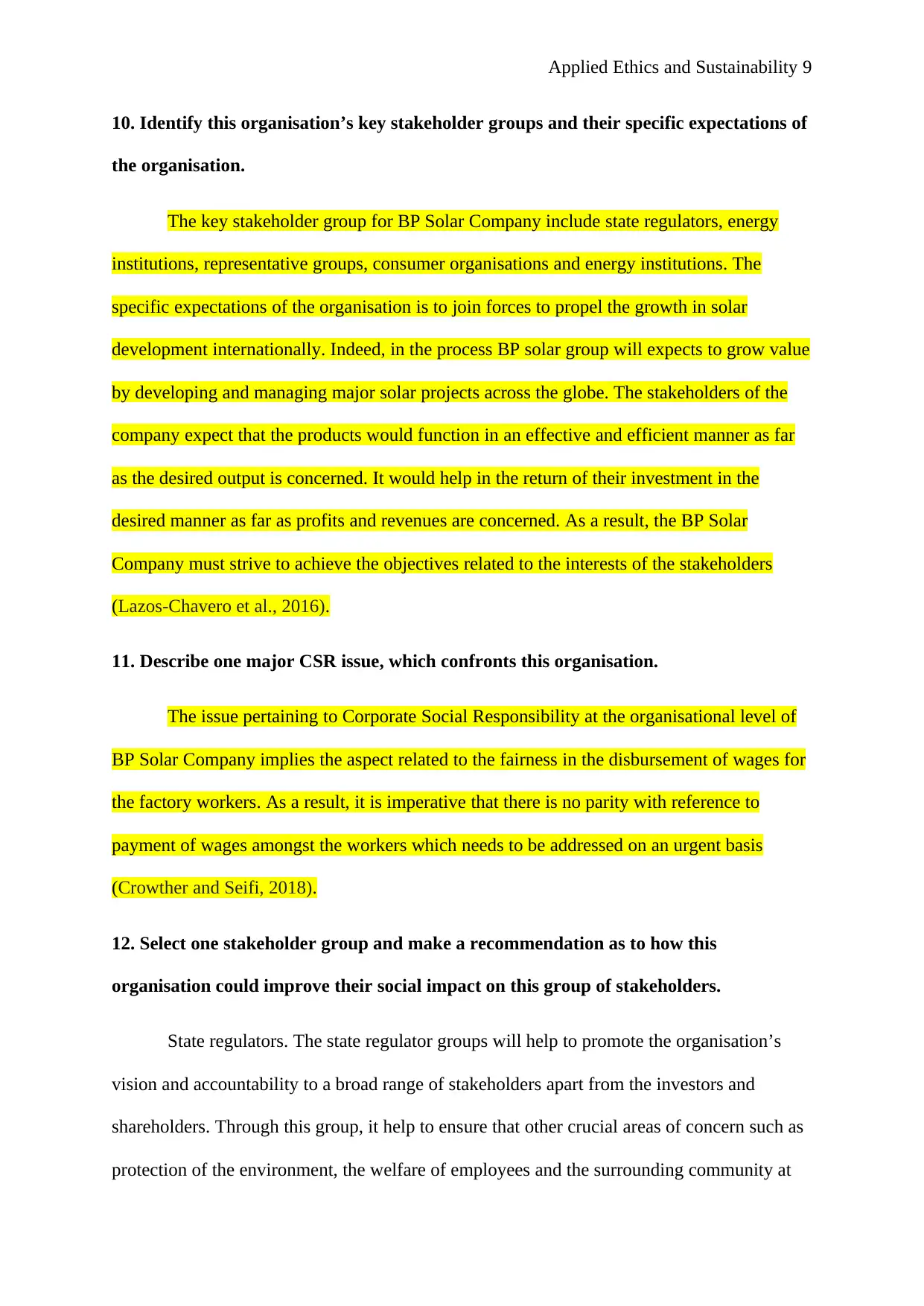
Applied Ethics and Sustainability 9
10. Identify this organisation’s key stakeholder groups and their specific expectations of
the organisation.
The key stakeholder group for BP Solar Company include state regulators, energy
institutions, representative groups, consumer organisations and energy institutions. The
specific expectations of the organisation is to join forces to propel the growth in solar
development internationally. Indeed, in the process BP solar group will expects to grow value
by developing and managing major solar projects across the globe. The stakeholders of the
company expect that the products would function in an effective and efficient manner as far
as the desired output is concerned. It would help in the return of their investment in the
desired manner as far as profits and revenues are concerned. As a result, the BP Solar
Company must strive to achieve the objectives related to the interests of the stakeholders
(Lazos‐Chavero et al., 2016).
11. Describe one major CSR issue, which confronts this organisation.
The issue pertaining to Corporate Social Responsibility at the organisational level of
BP Solar Company implies the aspect related to the fairness in the disbursement of wages for
the factory workers. As a result, it is imperative that there is no parity with reference to
payment of wages amongst the workers which needs to be addressed on an urgent basis
(Crowther and Seifi, 2018).
12. Select one stakeholder group and make a recommendation as to how this
organisation could improve their social impact on this group of stakeholders.
State regulators. The state regulator groups will help to promote the organisation’s
vision and accountability to a broad range of stakeholders apart from the investors and
shareholders. Through this group, it help to ensure that other crucial areas of concern such as
protection of the environment, the welfare of employees and the surrounding community at
10. Identify this organisation’s key stakeholder groups and their specific expectations of
the organisation.
The key stakeholder group for BP Solar Company include state regulators, energy
institutions, representative groups, consumer organisations and energy institutions. The
specific expectations of the organisation is to join forces to propel the growth in solar
development internationally. Indeed, in the process BP solar group will expects to grow value
by developing and managing major solar projects across the globe. The stakeholders of the
company expect that the products would function in an effective and efficient manner as far
as the desired output is concerned. It would help in the return of their investment in the
desired manner as far as profits and revenues are concerned. As a result, the BP Solar
Company must strive to achieve the objectives related to the interests of the stakeholders
(Lazos‐Chavero et al., 2016).
11. Describe one major CSR issue, which confronts this organisation.
The issue pertaining to Corporate Social Responsibility at the organisational level of
BP Solar Company implies the aspect related to the fairness in the disbursement of wages for
the factory workers. As a result, it is imperative that there is no parity with reference to
payment of wages amongst the workers which needs to be addressed on an urgent basis
(Crowther and Seifi, 2018).
12. Select one stakeholder group and make a recommendation as to how this
organisation could improve their social impact on this group of stakeholders.
State regulators. The state regulator groups will help to promote the organisation’s
vision and accountability to a broad range of stakeholders apart from the investors and
shareholders. Through this group, it help to ensure that other crucial areas of concern such as
protection of the environment, the welfare of employees and the surrounding community at
⊘ This is a preview!⊘
Do you want full access?
Subscribe today to unlock all pages.

Trusted by 1+ million students worldwide
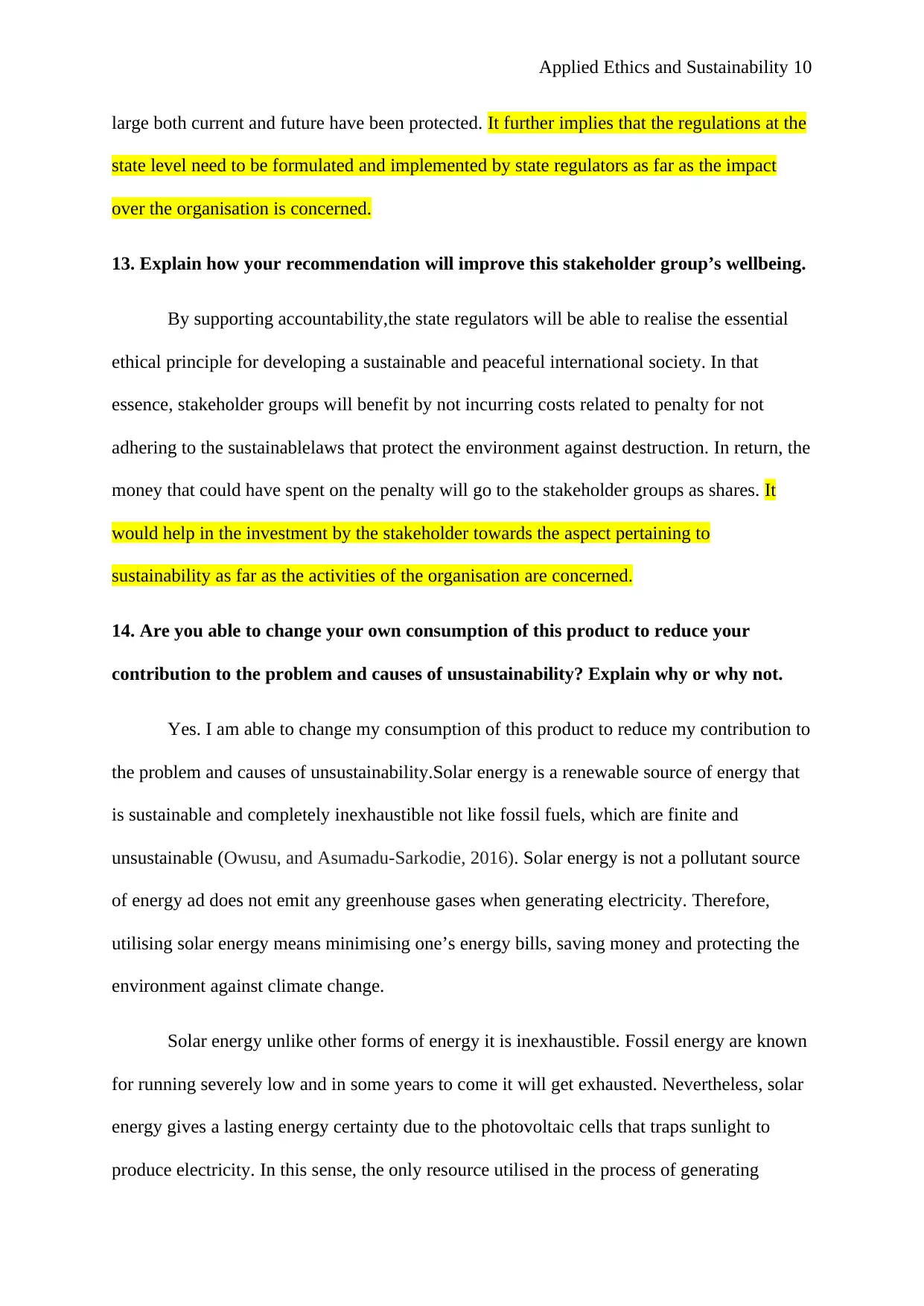
Applied Ethics and Sustainability 10
large both current and future have been protected. It further implies that the regulations at the
state level need to be formulated and implemented by state regulators as far as the impact
over the organisation is concerned.
13. Explain how your recommendation will improve this stakeholder group’s wellbeing.
By supporting accountability,the state regulators will be able to realise the essential
ethical principle for developing a sustainable and peaceful international society. In that
essence, stakeholder groups will benefit by not incurring costs related to penalty for not
adhering to the sustainablelaws that protect the environment against destruction. In return, the
money that could have spent on the penalty will go to the stakeholder groups as shares. It
would help in the investment by the stakeholder towards the aspect pertaining to
sustainability as far as the activities of the organisation are concerned.
14. Are you able to change your own consumption of this product to reduce your
contribution to the problem and causes of unsustainability? Explain why or why not.
Yes. I am able to change my consumption of this product to reduce my contribution to
the problem and causes of unsustainability.Solar energy is a renewable source of energy that
is sustainable and completely inexhaustible not like fossil fuels, which are finite and
unsustainable (Owusu, and Asumadu-Sarkodie, 2016). Solar energy is not a pollutant source
of energy ad does not emit any greenhouse gases when generating electricity. Therefore,
utilising solar energy means minimising one’s energy bills, saving money and protecting the
environment against climate change.
Solar energy unlike other forms of energy it is inexhaustible. Fossil energy are known
for running severely low and in some years to come it will get exhausted. Nevertheless, solar
energy gives a lasting energy certainty due to the photovoltaic cells that traps sunlight to
produce electricity. In this sense, the only resource utilised in the process of generating
large both current and future have been protected. It further implies that the regulations at the
state level need to be formulated and implemented by state regulators as far as the impact
over the organisation is concerned.
13. Explain how your recommendation will improve this stakeholder group’s wellbeing.
By supporting accountability,the state regulators will be able to realise the essential
ethical principle for developing a sustainable and peaceful international society. In that
essence, stakeholder groups will benefit by not incurring costs related to penalty for not
adhering to the sustainablelaws that protect the environment against destruction. In return, the
money that could have spent on the penalty will go to the stakeholder groups as shares. It
would help in the investment by the stakeholder towards the aspect pertaining to
sustainability as far as the activities of the organisation are concerned.
14. Are you able to change your own consumption of this product to reduce your
contribution to the problem and causes of unsustainability? Explain why or why not.
Yes. I am able to change my consumption of this product to reduce my contribution to
the problem and causes of unsustainability.Solar energy is a renewable source of energy that
is sustainable and completely inexhaustible not like fossil fuels, which are finite and
unsustainable (Owusu, and Asumadu-Sarkodie, 2016). Solar energy is not a pollutant source
of energy ad does not emit any greenhouse gases when generating electricity. Therefore,
utilising solar energy means minimising one’s energy bills, saving money and protecting the
environment against climate change.
Solar energy unlike other forms of energy it is inexhaustible. Fossil energy are known
for running severely low and in some years to come it will get exhausted. Nevertheless, solar
energy gives a lasting energy certainty due to the photovoltaic cells that traps sunlight to
produce electricity. In this sense, the only resource utilised in the process of generating
Paraphrase This Document
Need a fresh take? Get an instant paraphrase of this document with our AI Paraphraser
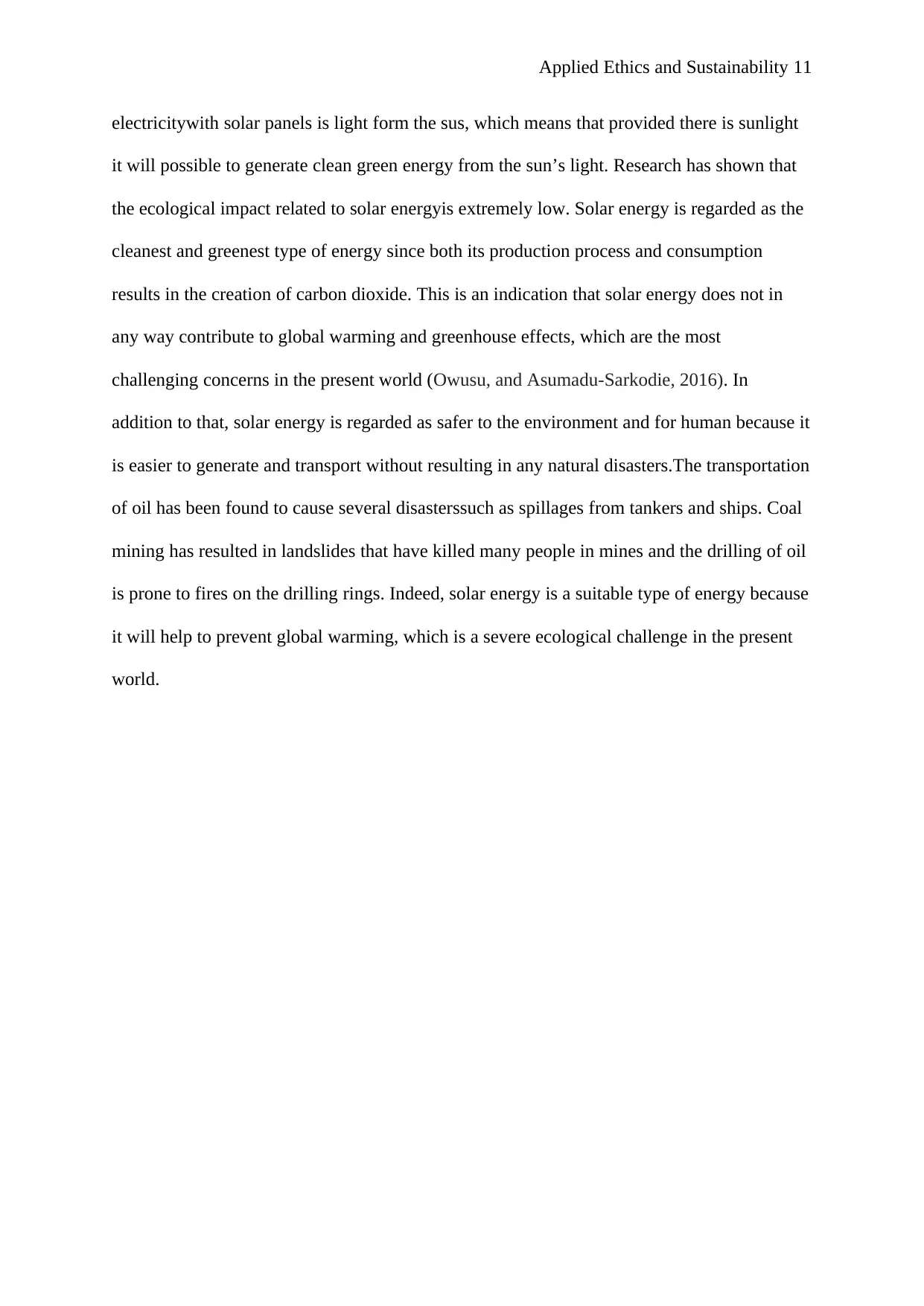
Applied Ethics and Sustainability 11
electricitywith solar panels is light form the sus, which means that provided there is sunlight
it will possible to generate clean green energy from the sun’s light. Research has shown that
the ecological impact related to solar energyis extremely low. Solar energy is regarded as the
cleanest and greenest type of energy since both its production process and consumption
results in the creation of carbon dioxide. This is an indication that solar energy does not in
any way contribute to global warming and greenhouse effects, which are the most
challenging concerns in the present world (Owusu, and Asumadu-Sarkodie, 2016). In
addition to that, solar energy is regarded as safer to the environment and for human because it
is easier to generate and transport without resulting in any natural disasters.The transportation
of oil has been found to cause several disasterssuch as spillages from tankers and ships. Coal
mining has resulted in landslides that have killed many people in mines and the drilling of oil
is prone to fires on the drilling rings. Indeed, solar energy is a suitable type of energy because
it will help to prevent global warming, which is a severe ecological challenge in the present
world.
electricitywith solar panels is light form the sus, which means that provided there is sunlight
it will possible to generate clean green energy from the sun’s light. Research has shown that
the ecological impact related to solar energyis extremely low. Solar energy is regarded as the
cleanest and greenest type of energy since both its production process and consumption
results in the creation of carbon dioxide. This is an indication that solar energy does not in
any way contribute to global warming and greenhouse effects, which are the most
challenging concerns in the present world (Owusu, and Asumadu-Sarkodie, 2016). In
addition to that, solar energy is regarded as safer to the environment and for human because it
is easier to generate and transport without resulting in any natural disasters.The transportation
of oil has been found to cause several disasterssuch as spillages from tankers and ships. Coal
mining has resulted in landslides that have killed many people in mines and the drilling of oil
is prone to fires on the drilling rings. Indeed, solar energy is a suitable type of energy because
it will help to prevent global warming, which is a severe ecological challenge in the present
world.
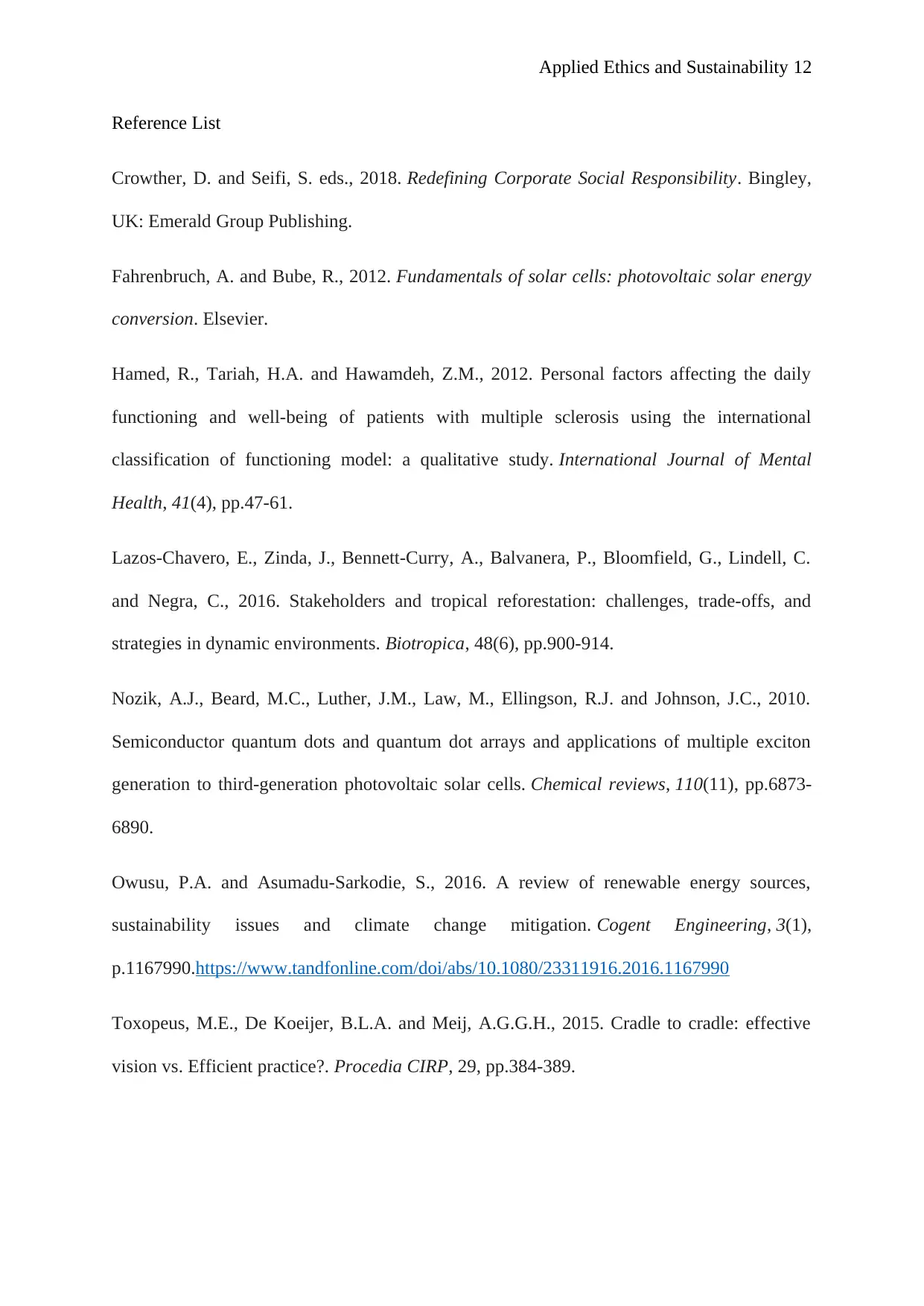
Applied Ethics and Sustainability 12
Reference List
Crowther, D. and Seifi, S. eds., 2018. Redefining Corporate Social Responsibility. Bingley,
UK: Emerald Group Publishing.
Fahrenbruch, A. and Bube, R., 2012. Fundamentals of solar cells: photovoltaic solar energy
conversion. Elsevier.
Hamed, R., Tariah, H.A. and Hawamdeh, Z.M., 2012. Personal factors affecting the daily
functioning and well-being of patients with multiple sclerosis using the international
classification of functioning model: a qualitative study. International Journal of Mental
Health, 41(4), pp.47-61.
Lazos‐Chavero, E., Zinda, J., Bennett‐Curry, A., Balvanera, P., Bloomfield, G., Lindell, C.
and Negra, C., 2016. Stakeholders and tropical reforestation: challenges, trade‐offs, and
strategies in dynamic environments. Biotropica, 48(6), pp.900-914.
Nozik, A.J., Beard, M.C., Luther, J.M., Law, M., Ellingson, R.J. and Johnson, J.C., 2010.
Semiconductor quantum dots and quantum dot arrays and applications of multiple exciton
generation to third-generation photovoltaic solar cells. Chemical reviews, 110(11), pp.6873-
6890.
Owusu, P.A. and Asumadu-Sarkodie, S., 2016. A review of renewable energy sources,
sustainability issues and climate change mitigation. Cogent Engineering, 3(1),
p.1167990.https://www.tandfonline.com/doi/abs/10.1080/23311916.2016.1167990
Toxopeus, M.E., De Koeijer, B.L.A. and Meij, A.G.G.H., 2015. Cradle to cradle: effective
vision vs. Efficient practice?. Procedia CIRP, 29, pp.384-389.
Reference List
Crowther, D. and Seifi, S. eds., 2018. Redefining Corporate Social Responsibility. Bingley,
UK: Emerald Group Publishing.
Fahrenbruch, A. and Bube, R., 2012. Fundamentals of solar cells: photovoltaic solar energy
conversion. Elsevier.
Hamed, R., Tariah, H.A. and Hawamdeh, Z.M., 2012. Personal factors affecting the daily
functioning and well-being of patients with multiple sclerosis using the international
classification of functioning model: a qualitative study. International Journal of Mental
Health, 41(4), pp.47-61.
Lazos‐Chavero, E., Zinda, J., Bennett‐Curry, A., Balvanera, P., Bloomfield, G., Lindell, C.
and Negra, C., 2016. Stakeholders and tropical reforestation: challenges, trade‐offs, and
strategies in dynamic environments. Biotropica, 48(6), pp.900-914.
Nozik, A.J., Beard, M.C., Luther, J.M., Law, M., Ellingson, R.J. and Johnson, J.C., 2010.
Semiconductor quantum dots and quantum dot arrays and applications of multiple exciton
generation to third-generation photovoltaic solar cells. Chemical reviews, 110(11), pp.6873-
6890.
Owusu, P.A. and Asumadu-Sarkodie, S., 2016. A review of renewable energy sources,
sustainability issues and climate change mitigation. Cogent Engineering, 3(1),
p.1167990.https://www.tandfonline.com/doi/abs/10.1080/23311916.2016.1167990
Toxopeus, M.E., De Koeijer, B.L.A. and Meij, A.G.G.H., 2015. Cradle to cradle: effective
vision vs. Efficient practice?. Procedia CIRP, 29, pp.384-389.
⊘ This is a preview!⊘
Do you want full access?
Subscribe today to unlock all pages.

Trusted by 1+ million students worldwide
1 out of 12
Related Documents
Your All-in-One AI-Powered Toolkit for Academic Success.
+13062052269
info@desklib.com
Available 24*7 on WhatsApp / Email
![[object Object]](/_next/static/media/star-bottom.7253800d.svg)
Unlock your academic potential
Copyright © 2020–2025 A2Z Services. All Rights Reserved. Developed and managed by ZUCOL.





